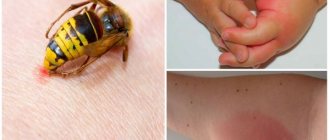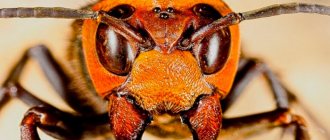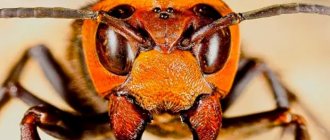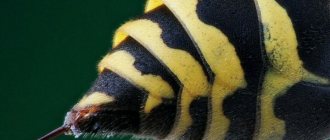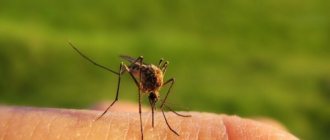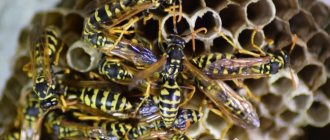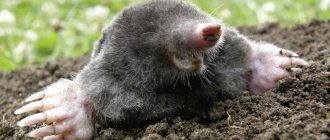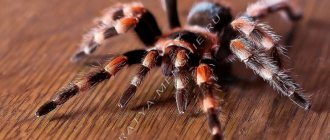Who dies after being stung: a bee or a wasp?
Insects use their stings for hunting, as well as self-defense and protection of the hive. Bees are not known for their aggressive disposition; they use their stings in emergency situations. Once stung, they continue to live for about 30 minutes. The bee sting has serrations that resemble a saw in appearance. Easily penetrates the skin, but cannot move back. After the jerk, the bee leaves the sting inside along with part of the abdomen. A few minutes later he dies.
On a note!
What happens to the wasp after a sting depends on the circumstances. The sting is needle-shaped. The surface is smooth, without jagged edges, protrusions, or thorns. It penetrates the skin easily and can be removed just as easily. In one attack, the wasp can bite up to 5 times, after which it quickly flies away.
Whether an insect dies or not - under such circumstances, no. Continues normal life activities and returns to the hive. However, it takes some time to recuperate. The wasp uses venom in special cases. When confronted with a potential victim, it uses its powerful jaws, and only then stings.
Why does a bee die after being stung, but not a wasp?
Many people repeatedly have to deal with bee or wasp stings. These insects fly especially often near flowering plants or trees, near sweets. Wasps can build a nest even on the balcony. Therefore, meeting these insects is not at all difficult.
The first thing a person feels after a bite is pain. A natural reaction arises - to take revenge on the offender. But often the bee or wasp simply flies away, leaving its stinger in the human skin.
Important: In fact, a bee sting is not harmless, even if it managed to fly away. Bees have it worse than humans. After all, it is known that after a bee stings, it dies.
Why is this happening? The bee's sting looks like a small harpoon - a point with small serrations. When the sting pierces a person's skin, the bee can no longer reach it back due to the fact that the elastic skin tightly compresses the barbs. The bee, in an attempt to reach its sting, tears off part of its intestine and flies away. The resulting injury leaves the bee no chance of survival, and the insect soon dies.
The situation is completely different with wasps. Unlike a bee's sting, a wasp's sting is smooth. If you look at the sting of a wasp and a bee under a microscope, you can see the difference. The wasp easily removes its sting after a bite and pulls it back into the abdomen. It is for this reason that a wasp can sting several times in a row until it splashes out all the poison. Even if for some reason, for example, when a person tries to kill a wasp, the sting remains in the skin, the insect does not die. The wasp simply loses its ability to sting a person.
This is what a bee and wasp sting looks like
Important: A wasp sting is one of the sharpest devices in the world. Some wasp stings are not only safe, but can also be beneficial. Scientists have proven that Brazilian wasps secrete poison that destroys cancer cells. The venom of such wasps acts selectively and does not damage healthy cells.
The sting of a bee or wasp is a complex tool. It is located in the abdomen. Thanks to the flexibility of the insect's body, the sting hits the target exactly. Worker bees and queen bees have a sting; drones do not have such an organ. In queens, the sting is a modified ovipositor; queens are not capable of stinging a person or animal. Worker bees sting, we'll talk about the reasons below.
Human bee sting
Does a wasp die after a bite - what happens to its sting
According to people, wasps are very annoying insects. They can be found much more often in urban environments than bees. Wasps make nests on balconies, in courtyards, and in parks. Meat pavilions and trays with sweets cannot do without their attention. Due to frequent encounters with insects, the chance of being bitten increases significantly. The result of a sting can be a severe allergic reaction and the victim often wonders whether the wasp dies after the sting. What happens to the offender after the attack - let's figure it out.
How wasps bite
The wasp's main weapon is its sting, which is an amazing and complex mechanism. Only females are equipped with “perfect weapons,” since the sting is nothing more than a modified ovipositor. Located at the end of the abdomen. When the insect is at rest and does not try to hunt anyone, the sting is hidden inside the body.
In case of danger, with the help of muscles, the tip of the sting moves outward. When attacked, the tip pierces the victim's skin and poison is injected. A person experiences pain not at all from a puncture, but from substances that are part of insect venom and cause allergic reactions, burning, itching.
On a note! The wasp sting is one of the sharpest devices in the world.
What happens to the wasp after a bite: using the same muscles, the sting is retracted back, and the wasp itself flies away further if the person does not injure himself while trying to swat the aggressor. In rare cases, a wasp may sting several times until the venom supply runs out.
Does a wasp leave a sting after a bite?
Disputes often arise regarding who dies after a sting: a bee or a wasp. There is no reason to worry about the fate of the wasp. Her sting is very smooth and she easily removes it from the body of her victim. In practice, an insect rarely loses its stinging instrument. If for some reason this happens, then there is no threat to his life.
Interesting! The stings of some types of wasps can be extremely beneficial. During research, scientists discovered that Brazilian wasps inject poison that destroys cancer cells. It is also noteworthy that the poison acts selectively and does not damage healthy tissue.
The difference between the stings is especially visible when viewed enlarged or under a microscope: bee on the left, wasp on the right
But the fate of the bee after the sting is more tragic. Its sting resembles a harpoon in appearance and is a needle with many barbs. The mechanism of action of the tool is similar to the operation of a wasp sting. After the attack, the insect attempts to remove its organ, but as a result, a muscular sac filled with poison and part of the intestine are torn off. Such an injury is incompatible with the life of the bee, and it dies.
How to remove the sting
Sometimes situations happen that the wasp sting remains in the skin. This happens in the event of the unexpected death of the offender. For example, having felt that someone is crawling on the skin, a person reflexively tries to kill, and only then considers who attempted to kill him
The sting should be removed very carefully and carefully, as it is very fragile. If it breaks off, it will be much more difficult to remove the short needle.
There is no point in delaying the removal of the foreign body, because the poison continues to flow into the wound.
The procedure consists of several stages:
- prepare tweezers, and if you don’t have them, treat a needle or pin with an alcohol-containing solution or heat it over a fire;
- grab the edge of the sting with tweezers, as close to the skin as possible and pull it out sharply;
- treat the affected area with a disinfectant solution.
Wasps attack a person if they sense a threat or danger from him. When stinging individuals appear, you should not actively wave your arms, trying to scare them away. This behavior can provoke even stronger aggression from the wasps.
THE LAST NOTES
Recent comments
The structure of a wasp sting
Female wasps use their sting for defense and attack. Its role is to paralyze the victim. If it is an insect, it is taken to the wasp hive for food.
The sting consists of:
- poison gland;
- pointed proboscis;
- internal duct.
It is through the internal duct that the poison from the gland enters the victim. The shape resembles a regular needle. Although it is thin, it is quite strong, as it consists of chitin. The formation of the weapon begins in the egg, so males, in principle, do not have the opportunity to possess it. The length of the sting is impressive, since the wasp extends it when biting. The proboscis and duct can be examined using a microscope.
How dangerous is the poison?
The insect is dangerous because its poison can cause a severe allergic reaction, even leading to death. Many people are unaware of their high sensitivity to this poison until the moment they are bitten. Although wasps sting quite often. The bite is accompanied by sharp pain, the wound swells, and a burning sensation is felt. This is the least you can get away with in such a situation. The consequences may be unforeseen.
The poison contains substances such as:
- phospholipase;
- melitin;
- histamine, etc.
The whole difficulty lies in the fact that without encountering a wasp, it is impossible to know about the presence of sensitivity to these substances. Therefore, an attack by a stinging insect can lead to unpleasant consequences and even death, although this is a very rare occurrence.
The properties of substances also include:
- destruction of body cells;
- causing tumor;
- triggering allergies;
- impact on the nervous system.
It is because of the action of the poison that the bite site becomes inflamed and does not heal for a sufficiently long period of time. Itching may also add to the pain. If the pain does not go away after 2 weeks, it is best to consult a doctor.
How much and how long the wound hurts may depend on the type of insect that stung. The bite of some individuals may be completely painless, while others will lead to suffering.
Most bites occur on the arms and legs. But cases of stinging in the head also occur. If the sting gets into the face, it may change beyond recognition. The eyelids swell to such a size that the eyes cannot see anything. Bites on the tongue often occur. This happens when a wasp sits on food, but a person did not notice it and took it into his mouth. The swollen tongue becomes so large that the mouth may not close.
How long do wasps live?
In early spring, the young queen begins building a nest and laying eggs. All summer, immature females appear - working individuals. They perform different functions, provide hive construction, protection, obtain food, and feed larvae. Life expectancy is no more than a month. The wasp society is rapidly expanding. By the end of summer the population numbers several hundred individuals.
In August, the wasps begin to attach additional honeycombs, which are slightly larger in size. There the queen lays eggs, from which females and males emerge. After birth, they remain in the hive for some time, then fly outside to mate.
Working individuals eat larvae, underdeveloped eggs, and leave the nest, on the construction of which they worked throughout the warm season. At the beginning of autumn they become slow and not so aggressive. With the onset of the first frosts they begin to die. Young queens hide in tree hollows, crevices, and wooden buildings. According to some sources, old queens die along with their family, according to others, they winter safely and live for about 2 years.
The bite does not affect life expectancy unless the person intentionally kills the attacker. In most cases, death occurs naturally or during a confrontation with a natural enemy.
Features of the bite
The statement that a wasp dies after biting a person is incorrect. This happens if a person intuitively swats an insect. But in most cases, he shakes off the pest, throwing it away from him.
Wasp and bee sting
The sting is used by the insect for hunting and self-defense. However, any human movement is regarded as aggression, and the wasp rushes to attack. Landing on the body, it compresses the abdominal muscles and launches a sting. Instantly launches poison. If a person waves his arms or makes sudden movements, the attack can occur again, up to 5 times.
On a note!
When a wasp bites or dies, a secret is released that is sensed by other relatives. If there is a nest nearby, in a few seconds you will have to fight off a whole swarm. In this case, a dead wasp is more dangerous than a living one, so you need to try to get rid of the insect, but not kill it.
What to do if bitten by a wasp
If assistance is provided promptly and correctly, then serious consequences can be avoided.
- If a sting is found at the site of the bite, it must be removed.
- The wound should be disinfected with whatever is at hand: hydrogen peroxide, iodine, cologne, antiseptic solution, calendula tincture, alcohol, or simply washed with soap and water.
- Apply cold to the bite site for 20 minutes. You can use ice or a cloth soaked in cold water. This will help reduce pain and prevent further spread of edema, as this causes vasoconstriction.
- If a wasp stings your arm or leg, you can apply a tight bandage to prevent the spread of the poison.
- Be sure to take anti-allergy medication: Suprastin, Zodak, Cetrin, Claritin. Sometimes the use of hormonal drugs is required.
- An ointment containing hormones or antihistamines, for example, Advantan, Hydrocortisone ointment, Fenistil gel, helps against a wasp sting.
In order to avoid complications such as wound infection and rapid spread of poison throughout the body, you must not:
- comb the bite site;
- try to squeeze the poison out of the wound;
- use water from nearby reservoirs for cooling;
- drink alcohol.
First aid for a child with a wasp sting is provided in the same way as for adults. Pregnant women are not recommended to take hormones and antihistamines on their own; the use of any medications is only after consulting a doctor.
If urticaria, Quincke's edema and anaphylactic shock appear, you should immediately call an ambulance. Be sure to consult a doctor if a wasp stings your face.
The day after the wasp sting, treatment is continued. The same antihistamines and, if necessary, hormonal drugs in the form of tablets and ointments are prescribed until the condition improves and the swelling goes away. This may take from one day to five days, sometimes more.
For urticaria and Quincke's edema, drugs are administered intramuscularly or intravenously in the first days, then switch to taking tablets. Anaphylactic shock requires treatment in a hospital setting.
First aid for a bee or wasp sting
A bee or wasp injects poison into the human body using its sting. Therefore, the skin swells, turns red and hurts. If you have been stung by a wasp or a bee, you must urgently take action and provide first aid:
- Get the sting. This can be done using tweezers or a needle. The tweezers or needle should be wiped with a disinfectant solution, and after removing the tip, the skin area should also be disinfected.
- Apply a cooling compress or ice.
- Take an antihistamine (Eden, Claritin, Fenistil, L-cet, Diazolin, Erius, Zodak, etc.)
After the bite, pain and swelling can be felt for a long time. Wasp stings tend to be more painful than bee stings.
Children are often stung by bees or wasps:
- Firstly, children love to eat sweets, which attracts insects;
- Secondly, it is impossible to force children to calm down; they will wave their hands when they see a dangerous insect;
- Thirdly, children often play outdoors and can stir up a wasp’s nest; in this case, bites are inevitable.
Therefore, your first aid kit should always contain the following items to help your child:
- Antihistamine syrup. It is recommended to take it, even in the absence of signs of allergy, the syrup will relieve pain.
- Cooling ointments for insect bites (Moskitol, Psilo-Balm, Fenistil gel).
- You can apply skin-restoring creams to the bite area (Bepanten, Panthenol, Dexpanthenol, baby cream).
If such a nuisance happens to a child, do not panic, this will cause even greater fear in an already excited baby. Try not to panic and provide timely assistance to the child. Children are unlikely to have a strong reaction to the first bee sting. But this case may provoke insect allergies in the future.
Help with bee stings
There are terrible cases when a person is allergic to bee and wasp stings. The person's condition may be poor:
- The temperature may rise.
- Swelling extends more than 10 cm from the point of the bite.
- There is dizziness, shortness of breath, heavy breathing.
- Heart rate increases.
A person may not be aware of the fact that he has an allergy until he is stung by a bee. If the above reactions are observed, you should urgently contact an ambulance. Before the ambulance arrives, the following actions are important:
- If a bee has bitten a limb, apply a tourniquet 15 cm above the bite. You cannot hold the tourniquet for more than 45 minutes.
- Apply an ice compress to the area around the bite.
- Crush the suprastin tablet so that the victim can swallow it if the larynx suddenly swells.
Bumblebee sting and first aid
Know that a bumblebee will never attack if you don’t touch it. Remember that only the female has a sting. By killing this insect, you can incur aggression from female bumblebees. They feel that a relative has been attacked, and quickly fly to the rescue. It also happens that no one touched him, but the bumblebee bit him. For example, during its next dive, an insect, crashing into a person’s body, released its sting in a moment of fright. What to do if it stings and injects poison into the skin?
You immediately need to calm down and remember how to relieve swelling and redness caused by insect venom injected into the skin. The allergic person should be quickly transported to the hospital. In addition, it is necessary to provide immediate assistance to the victim.
1. Inspect the site of the bumblebee attack. It may happen that after a bite the sting remains in the skin. It must be carefully removed, and then the wound must be disinfected. 2. Apply cotton wool soaked in peroxide and manganese water. 3. Ice, wrapped in a flap, applied to the wound and bandaged. 4. Take suprastin or another antiallergic drug to the victim.
Swelling, pain and unbearable itching will be felt for several days
It is important for the victim to drink a lot of water so that the poison is eliminated faster. It is strictly forbidden to scratch the bite, otherwise the consequences will be disastrous. If the condition worsens, you feel a racing heart, your limbs go numb, you constantly want to sleep, you should go to the hospital
If the condition worsens, you feel a racing heart, your limbs go numb, and you constantly want to sleep, you should go to the hospital.
Stinging insect bites are dangerous
It doesn’t matter whether the victim is prone to allergies or is in excellent health, the body’s reaction to the poison introduced by the sting can be fatal. The use of folk remedies for a bite to numb the wound is allowed only in cases where there is no allergy and the swelling has begun to subside. It is important to remember that you can apply healing herbal leaves to the bites after thoroughly cleaning them
It is important to remember that you can apply healing herbal leaves to the bites after thoroughly cleaning them. Still, it’s wiser not to meet these insects
You cannot brush them off with your hands, so as not to cause aggression, destroy the nests, and in the summer, carefully look to see if the wasp has become hooked on the sweet fruit so that it can also feast on it. If the insect stings, do not panic. By completing all emergency procedures correctly and going to the hospital on time, unpleasant consequences can always be avoided
Still, it is wiser not to encounter these insects. You cannot brush them off with your hands, so as not to cause aggression, destroy the nests, and in the summer, carefully look to see if the wasp has become hooked on the sweet fruit so that it can also feast on it. If the insect stings, do not panic. By completing all emergency procedures correctly and going to the hospital on time, unpleasant consequences can always be avoided.
How to relieve swelling after a bee sting using folk remedies?
Important: Situations when there are no medications at hand to provide first aid for insect bites happen often. Tourists, those who like to relax in nature or in the countryside should not forget about this safety rule.
But when there are no medications at hand, and a bee has bitten you, you can try to relieve the pain and also relieve swelling using folk remedies:
- Lotions with soda. Dilute a teaspoon of baking soda in 1 glass of water, soak a piece of gauze in this solution, and apply to the sore spot.
- It is recommended to drink tea or a glass of water with lemon.
- Activated charcoal and aspirin will help remove the poison. There is no need to take these tablets orally, because there is no food poisoning. You should crush the tablets and add a little water to make a paste. This mixture must be applied to the sore spot.
- Chopped parsley leaves will help relieve swelling. To do this, fresh parsley needs to be chopped and poured with boiling water. When the liquid has cooled, soak a cotton pad in the solution and apply to the swelling.
- It is not for nothing that the aloe plant received the nickname “house doctor”. It saves in many cases, and is also effective against bites of winged insects. You can apply aloe juice or a whole leaf to the swelling, with the pulp to the sore spot. Pain, redness, and swelling disappear after several applications of aloe.
- Onions contain bactericidal substances that eliminate poison components. Just a few minutes after applying the onion, the swelling decreases significantly and the redness goes away. The onion can be applied in the form of a paste, as well as a cut half. The main thing is that the juice stands out.
- Iodine mesh helps relieve swelling. It fights the inflammatory process at its initial stage.
- Olive oil. Chilled olive oil will help relieve swelling. Unsaturated fatty acids promote skin regeneration and restoration.
- Yarrow compress. The leaves of this plant can be mixed with parsley leaves, crushed into a paste and applied to the bite site.
- Fresh potato slices cool the burning pain and reduce swelling.
Folk remedies for bee stings
How to treat a bite
Even if a person does not suffer from allergies, he still needs to know what to do at home if he is bitten by a wasp, especially a child. The stings are very painful, the pain is stronger than from a bee. Relieving pain is the main task. In hot and sunny summers, you also need to know the rules of first aid for sunstroke and heatstroke.
First aid
The affected area needs to be washed and a cold compress applied.
Let's find out what to do if a wasp has bitten an arm, leg (the most common cases) or another part of the body:
- Rinse the affected area with cold water to remove dirt and any remaining poison. You can also apply a cold compress or a piece of ice.
- Disinfect the wound - alcohol, iodine, hydrogen peroxide, etc. will do.
- If swelling and itching intensify, then lubricate the affected area with an antihistamine such as Fenistil gel. An alternative is to apply a piece of cloth soaked in vinegar.
- Take Suprastin, Claritin, Loratadine tablets to avoid allergy complications.
- In case of anaphylactic shock or angioedema, seek medical help immediately. While waiting for the medical team, the victim needs to take a supine position, placing his legs at a level above his head.
- In case of general intoxication of the body, it is recommended to drink a lot of liquid - it can be plain water or very sweet tea.
There is no need to try to pick at the wound to find the sting, because only bees leave them.
What to do if a wasp bites a child? First, give an antihistamine according to the age category, then disinfect the wound and use folk remedies (lemon juice, onion, vinegar) to neutralize the poison.
How to treat the affected area
- In case of severe itching, you can apply grated raw potatoes to the wound.
- Fresh celery juice mixed with a little wine vinegar will help relieve itching.
- You can use compresses made from pharmaceutical alcohol or pure distillate.
To relieve swelling and itching, apply a cut onion to the affected area for 15 minutes. - Apply the cut onion and leave for 15 minutes. This vegetable will secrete juice, which, penetrating into the irritated area, will relieve swelling and itching.
- Calendula essential oil has a calming effect.
- Lemon juice helps eliminate swelling.
- The wound can be treated with a banana. To do this, you need to steam it, peel it and cool it. Then mash with a fork until it becomes a thick jelly and rub the bite area with it.
- Apply a handkerchief soaked in vinegar for half an hour.
Allergy to wasp venom
Insect venom releases histamine and other components that trigger the onset of an allergic reaction. Therefore, you need to know what to do if a wasp bites you and a person’s arm or leg swells.
Allergies are divided into several degrees of severity:
- Mild degree. Redness and swelling at the site of the bite (a normal reaction of the body).
- Average degree. Redness and swelling, difficulty breathing, abdominal cramps, diarrhea and vomiting.
- Severe degree. Anaphylactic shock develops. In this case, immediate medical attention is required.
The increased risk of developing a severe anaphylactic allergy reaction most often occurs in people with chronic heart problems and asthmatics . If a local allergic reaction occurs (swelling around the bite site), you must do the following:
- Take an antihistamine as soon as possible. It blocks the action of histamine, a substance that is released by some cells in the body during an allergic reaction.
- Apply a cold compress to reduce pain and swelling. You can use a piece of cloth or an ice bag.
- What to do if a wasp has bitten your finger and a person experiences excruciating discomfort throughout the entire arm: analgesics such as paracetamol or ibuprofen will help, they relieve pain .
- If a severe allergic reaction develops, the allergic person must be given adrenaline.
Wasp: characteristics, features, habitat
In the next video, a candidate of medical sciences will tell you how to provide assistance with a wasp sting.
Allergy tests
To diagnose an allergy to insect venom, a skin test or blood tests for specific IgE antibodies are performed. The only way to alleviate the symptoms of an allergic reaction is to systematically administer small doses of insect venom. This procedure is performed in a hospital or outpatient setting. Your doctor will give you an injection regularly to help keep your immune system functioning properly. This treatment lasts 5 years and guarantees a 90% result.
If the swelling becomes more and more, this is a reason to consult a doctor.
If an anaphylactic reaction occurs, allergy tests with a type of insect allergen should be performed 2-3 weeks after the bite.
Recommends performing a skin prick test . In this case, variously diluted amounts of insect venom are applied to the skin, and then the skin itself is injected with a special lancet.
Depending on the body's reaction, the degree of the allergic reaction is determined. If the first test is negative, it should be repeated after 4-6 weeks. Such manipulations should only be performed by an experienced allergist, who can skillfully prevent the development of allergies during the test.
Anaphylactic shock from a wasp sting
If anaphylactic shock occurs after a wasp sting, it is extremely difficult to survive without the help of loved ones. About 15% of those who experience it die. Anaphylactic shock is characterized by severe pain in the chest, as well as bluish discoloration of the extremities. It is preceded by the allergy symptoms listed above.
If you have experienced anaphylaxis once, know that any subsequent wasp sting will cause the same reaction or even worse, so stock up on the necessary medications and keep them with you.
An interesting feature of the reaction of the human body: when a wasp stings, the body does not develop immunity to the poison, but on the contrary, there is a figurative “accumulation”, i.e. with each subsequent bite the reaction will become stronger and stronger, and may even lead to anaphylactic shock, although a couple of years ago there was just a slight allergy.
Preventing wasp stings
To avoid a wasp sting, you need to know why these insects attack people and be careful. You need to be especially careful:
- having a picnic in nature;
- pruning fruit bushes and trees;
- picking berries or fruits, especially in the second half of summer;
- being in a wooden shed, in an attic, in a bathhouse;
- throwing garbage into a street container.
A wasp attack can be provoked by a sugary sweet aroma or the smell of food. When insects appear nearby, you must behave calmly, do not wave your arms, otherwise she will begin to defend herself.
In what case can a bite be fatal?
It is not the bite itself that is dangerous, but the body’s reaction to it. In the event of a strong immune reaction of the body to wasp venom, angioedema may occur, which, in the absence of qualified assistance, can kill a person. In the same way, a wasp bite on the neck or tongue can lead to severe swelling that blocks the airways, asphyxia and death.
More than one case of human death from an allergic reaction to a wasp sting has been recorded. Most often, victims die when there was no one around them who could help and provide first aid, give an antihistamine and call a doctor.
A severe allergic reaction is manifested by the following:
- severe swelling of the face or neck;
- itching and urticaria;
- dizziness;
- difficulty breathing;
- pressure drop;
- stomach cramps, diarrhea;
- nausea and vomiting;
- change in heart rate (increase or decrease in the number of beats per minute).
Signs of a wasp sting
The main symptoms of a wasp sting:
- burning pain in the affected area;
- skin redness;
- edema.
Bite
These signs appear in everyone, but sometimes an allergy occurs, which manifests itself as follows:
- severe swelling spreading far beyond the bitten area;
- itching;
- rash;
- labored breathing;
- too fast or slow pulse;
- dizziness, weakness;
- high temperature, fever, chills;
- nausea, vomiting.
In a healthy person, symptoms disappear 1 to 3 days after he was attacked by wasps. But it also happens that recovery takes several weeks.
Allergic reaction
The action of immunoglobulins in a healthy body can neutralize the effect of poisons. Its production begins immediately after the foreign substance enters the body.
If the person bitten is allergic to wasp venom, the reaction to the bite may be unpredictable. You can distinguish an allergic reaction from a normal one by the location of the bite. The first thing that will confirm the guesses is large swelling, more than 1 cm in diameter. The further occurrence of reactions depends on the human body.
Interesting! Allergy sufferers are issued special passports indicating personal data, allergen tests and first aid measures.
Allergy symptoms also:
- rash;
- strong pain;
- burning, itching;
- hives.
In addition to local reactions, the following may appear:
- headache, dizziness;
- nausea;
- decrease in blood pressure;
- difficulties with the breathing apparatus;
- elevated temperature;
- pale skin;
- muscle spasm.
The manifestation of the listed symptoms can begin within 20 minutes after the sting.
Anaphylactic shock that develops within the first 5 minutes is a strong and dangerous reaction of the body. It begins with difficulty breathing and swelling of the larynx. If such a reaction occurs, immediate medical attention must be provided. Prednisolone and adrenaline are administered, and a tourniquet is applied above the wound. Further treatment is carried out in a hospital setting.
Conclusion
Can you die from a wasp sting? Yes , but only in the case of a severe allergic reaction, the bite itself and the poison are not fatal.
Therefore, be careful around these insects and closely monitor for any signs of allergy symptoms after a bite. Seek help from specialists in a timely manner.
Sources
- https://apest.ru/osy/ukusy-os/umiraet-li-osa-posle-ukusa/
- https://heaclub.ru/pochemu-pchela-umiraet-posle-ukusa-posle-togo-kak-uzhalit-a-osa-net-pochemu-pchely-i-osy-zhalyat-lyudej-pervaya-pomoshh-pri- ukuse-pchely-ili-osy-narodnye-sredstva-ot-otekov
- https://klopkan.ru/osy/kak-osa-zhalit-ili-kusaet-ostaetsya-li-zhalo-i-umiraet-li-ona/
- https://WikiParazit.ru/osy-i-pchely/napadenie-os-i-lechenie-ukusa.html
- https://TaraKlop.ru/osy-i-shershni/umeret-ot-ukusa-osy/
[collapse]
